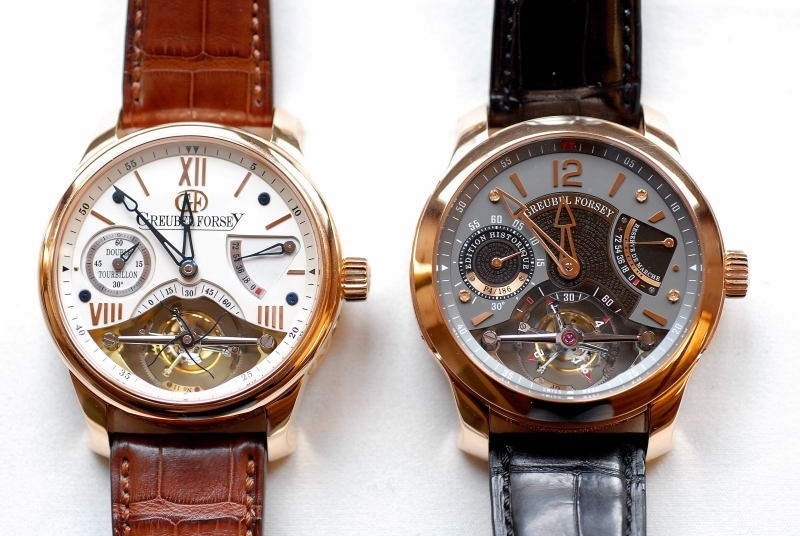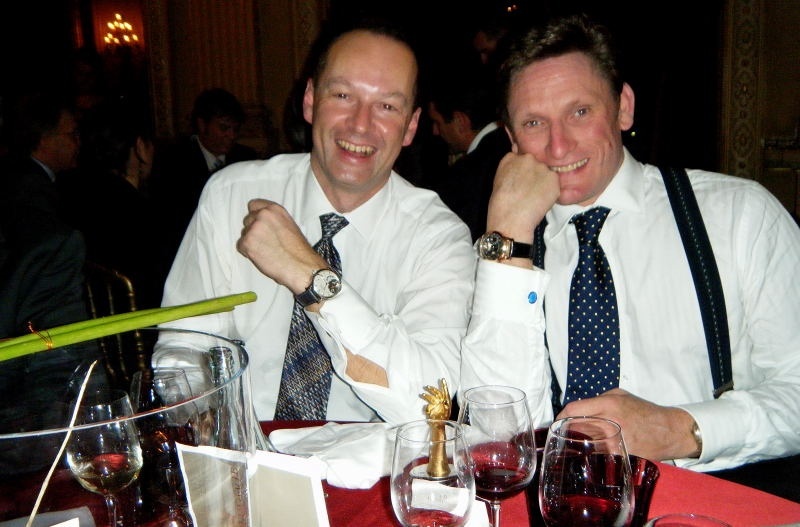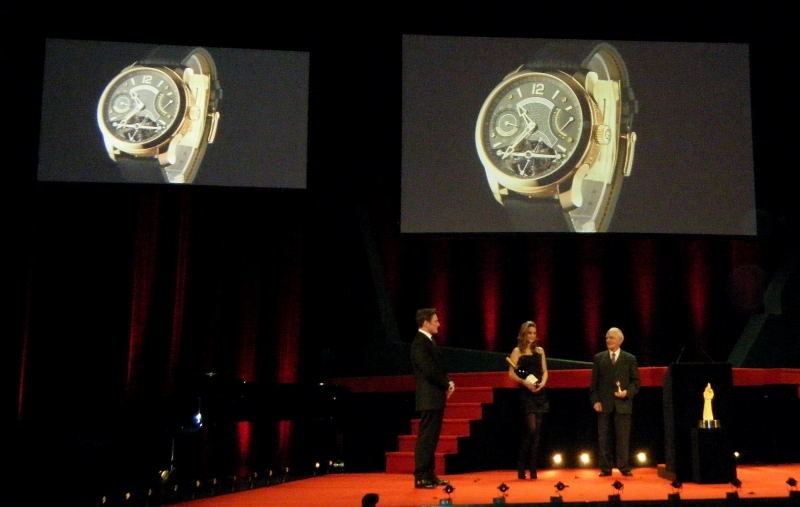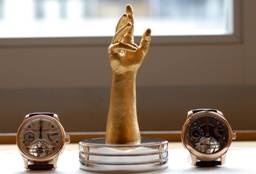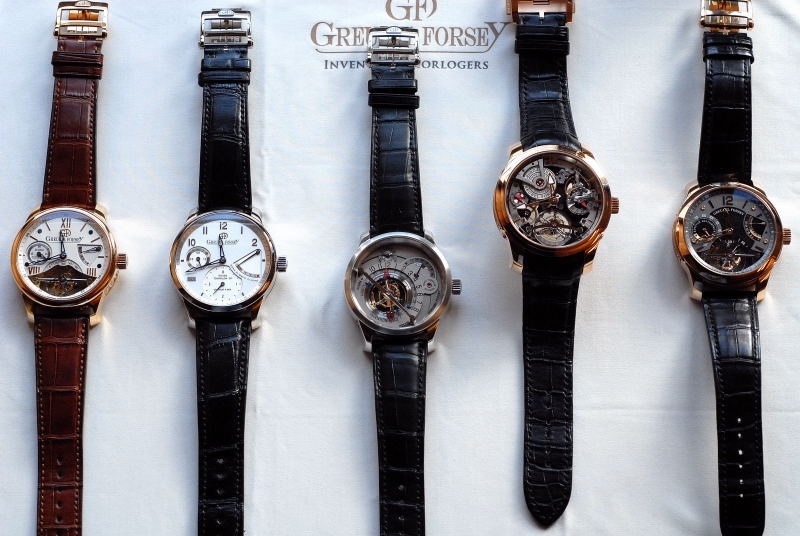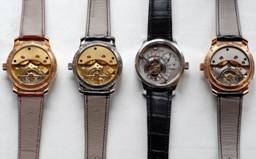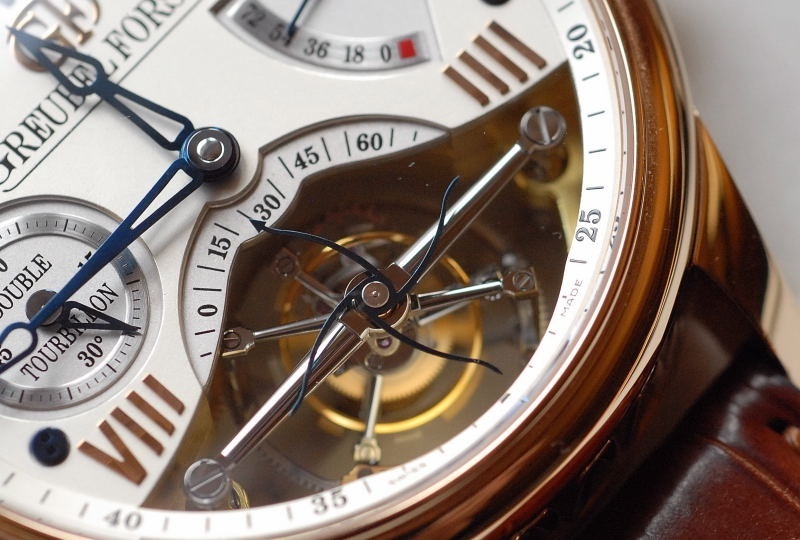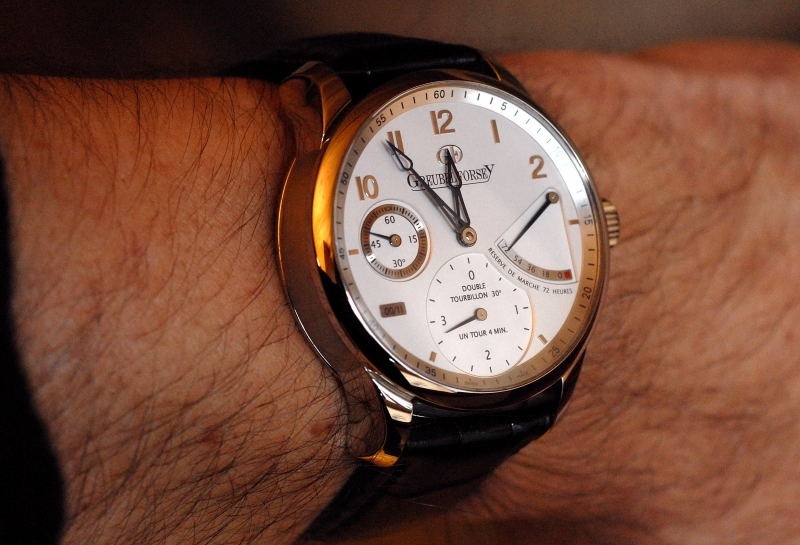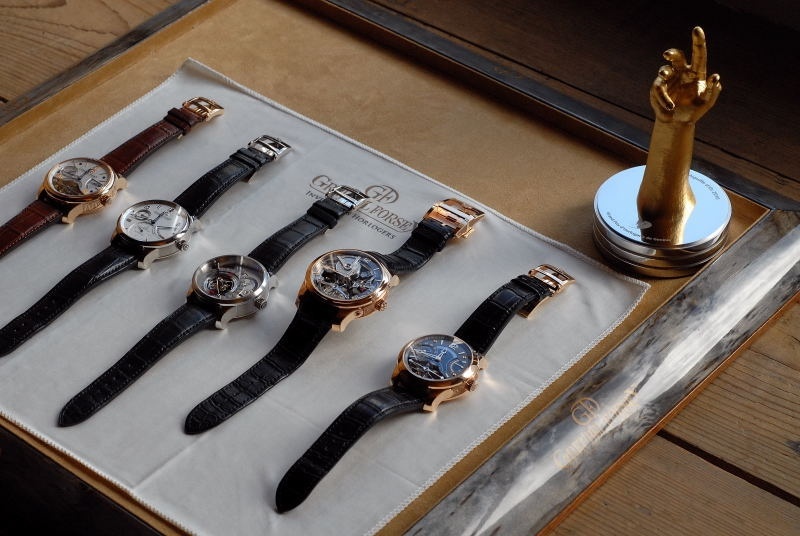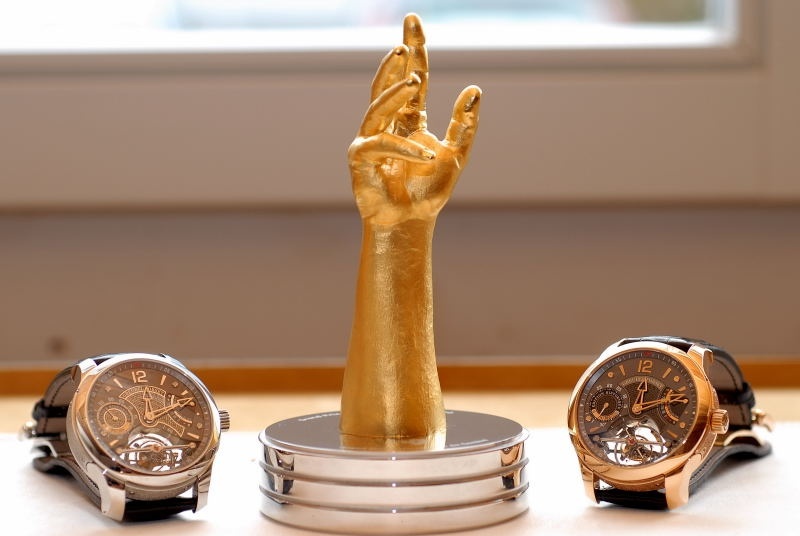
219
3826

Making History: Last 22 Watches of the Greubel Forsey Double Tourbillon 30° Contemporaine
[The Greubel Forsey Double Tourbillon 30° Contemporaine: The beginning and the
end of the model)
Even before Greubel Forsey as a watch firm existed in Robert and
Stephen's minds, they had an idea for a Double Tourbillon where the angle
of rotation (for the first cage) was pitched at 30 degrees. The two horological
innovators had considered the possibility of developing it with a watch company
but realized that this idea, and the scope for developing new tourbillon
systems, was sufficiently important to the watch world that they abandoned this
idea. While Robert and Stephen did not think that the world necessarily needed
another watch brand, they nonetheless decided to launch: Greubel Forsey.
The Double Tourbillon 30° Contemporaine debuted at Baselworld in 2004 to wide
acclaim and the firm has not looked back. In 2009, Greubel Forsey picked up the
prestigious Prix Gaïa for Esprit d'entreprise at the MIH museum in La
Chaux-de-Fonds for the firm's growth and establishing their place in the
watch market; this year, with the last 22 Double Tourbillon Contemporaine
movements designated to the Edition Historique, they picked up the 'L'Aiguille
d'Or'. Greubel Forsey are 'on the up' and not one('s)
to ever look back, they decided that this would be the end of the model before
moving on to new creations. The Double Tourbillon 30° mechanism itself will
live on in the Quadruple Tourbillon and the Double Tourbillon Technique, but
the model Double Tourbillon 30° Contemporaine itself, that launched Greubel
Forsey, will now be closed.
[Photo of yours truly and Stephen Forsey at the dinner after the Geneve Grand
Prix; Stephen wearing the Double Tourbillon 30° Edition Historique, yours truly
with the 24 Second Inclined Tourbillon]
I had the great fortune to be with Stephen Forsey on the night of this
year's Genève Grand Prix when the Double Tourbillon Edition Historique
brought home the 'L'Aiguille d'Or'. I asked Stephen, why now, why
with this version of their first invention, did they win the prestigious prize?
(For the record, the Quadruple Tourbillon picked up the Complication prize at
the Grand Prix d'Horologie in Asia in
2009). Stephen felt that this had been a vote for the invention itself; a
recognition of the time keeping properties that the inclined double tourbillon
had achieved, along with the quality of the movement and the creation, (design)
of this timepiece. It was recognition, not just of the watch, but the whole
team that is Greubel Forsey; those at the manufacture in Chaux-de-Fonds, the
suppliers and the retailers that have helped build the firm in its entirety.
[Stephen Forsey receiving the 'L'Aiguille d'Or' from Walter
Lange at the Geneve Grand Prix 2010]
Given that the Grand Prix Jury decided to give the prize to this version of the
watch that had launched Greubel Forsey to the world, this did seem to be an
appropriate moment to look back and reflect on the mechanism and the different
watches in which it has been presented.
[Giving the invention a hand! The 'L'Aiguille d'Or' with the
first and the last of the Double Tourbillon 30°Contemporaine].
Limited by their capacity to fulfill the technical and aesthetic quality
requirements for the Greubel Forsey watches, the number of movements in the
series had never been planned as a limited edition in a conventional way; there
had never been a plan or design to produce (say) 200 double tourbillon
movements. Robert and Stephen decided to number individually each timepiece and
at some point, the series would naturally come to a close.
A simple strategy, and one which limits (in unknown quantities ) the number of
watches that will be produced for any Greubel Forsey model. The Double
Tourbillon 30°Contemporaine model that was presented in 2004 and show-cased
Robert and Stephen's first invention was one, in which the mechanism
itself was highlighted in the movement design. Because of the 3 dimensional
aspect of the Double Tourbillon mechanism: the one minute tourbillon rotating
on an axis of 30 degrees; the four minute tourbillon rotating in vertical plane
every four minutes. The rotation of the one minute (angled) and the four minute
cages ensured that over the course of a 24 hour cycle the escapement wheel
would move through all possible fields and compensate for the effects of
gravity by avoiding horizontal/vertical positions. Tested through Greubel
Forsey's EWT (Experimental Watch Technology), the movement had shown
superior timekeeping over the single plane tourbillon in a wrist watch or with
a basic lever escapement.
[A pattern language: from left to right: the original Double Tourbillon 30°
Contemporaine; the Double Tourbillon 30°Secret; Invention Piece Double Tourbillon
30° Technique; Double Tourbillon 30° Edition Historique]
[A pattern language for the movement: from left to right: the original Double
Tourbillon 30° Contemporaine; the Double Tourbillon 30°Secret; Invention Piece
1; Double Tourbillon 30° Technique and Double Tourbillon 30° Edition Historique]
While at the same time, other brands started producing multi-axis tourbillons
(miniaturised from Anthony Randall's 90° 2 axis carriage clock concept),
for Robert Greubel and Stephen Forsey the route of no compromise on the new
technical innovation as well as the finishing for the Greubel Forsey timepiece
rather than using an existing miniaturized concept, made the difference between
the Greubel Forsey's Double Tourbillon 30° degree and the others. The
whole aesthetic of the timepiece was to draw attention to the Double Tourbillon
30° mechanism and the double tourbillon's movement. Through the sapphire
case back, the movement was a vision of simplicity and sophistication. What is
visible are the dual main spring barrels, with the remainder of the gear train
essentially remaining hidden with the base plate. The frosted gold finish, and
exact polished edges was reminiscent of French and English finishing on watches
some 200 years ago; appropriate given the nationalities of the two founders.
[The Double Tourbillon 30° mechanism through the dial]
I asked Stephen if any changes to this movement had been made in the past 6 ½
years since the introduction of the timepiece. Only one apparently: in 2008.
The change is small, subtle and has probably gone un-noticed, but it is there.
Earlier versions of the watch had the four minute sub-dial with its'
four-armed blue steel hand and a pipe in steel, with flat polished centre.
While this was seen as the pure approach, it proved to be unsatisfactory to
produce and so was replaced by a riveted, flat polished white gold pipe.
[Different forms: a "Double Tourbillon 30° Contemporaine" movement
and mechanism for the timepiece on the right: the "Secret"]
There have also been a number of variants of this mechanism over the past 6 ½
years; the most recent of which (the Technique) will continue in production.
There have been three limited editions (each in unique series of 11). The first
of these was the Double Tourbillon 30° "Secret". I have to admit
that this is my favourite variant of the watch. On the wrist, for all intents
and purposes it looks like a simple time-only, power reserve, watch that looks
well proportioned and elegant. A little larger than most time-only watches, the
blued hands and the white dial make it, to my eyes, a stunning watch. However,
a sharp eyed watch enthusiast would have noticed that there is essentially one
dial too many. Where you might expect the off centre second hand, you have a
dial that indicates 4 minutes. The movement is hidden and can only be seen when
the watch is off the wrist. The watch appeals to me as the truest and perhaps the
purest form for a watch in the traditional sense and style. On the surface a
beautiful legible reading of the time (hours, minutes, and hours), and the back
the beauty of the movement is there to be seen.
The other variant of Greubel Forsey's first invention was appropriately
put together in Invention Piece 1. This was a stunning variant of the invention
and it took the watch world by storm. Named as Robb Reports 'Best of the
Best' and instantly showed the inventiveness of the two horological
innovators. Using traditional materials and watchmaking techniques, Greubel
Forsey demonstrated how innovative a watch could be in both aesthetic design
and in terms of the movement. Designed so that the watch
'showcases' the invention first and foremost. It did, and still
does produce that 'wow' factor from watch enthusiasts and I have no
doubt that it will stand the test of time. The difficulties, outside of the
actual mechanism and movement itself were to 'black polish' parts
such as the long bridge on the top of the tourbillon; the difficulty being due
to the length of the bridge and having a flat surface to polish on such a part.
Other difficulties are more subtle, such as combining the different finishes on
the sub-dials (which were finished from sold white gold) and the rest of the
watch face to achieve the desired look of the watch; and on reverse side of the
watch, for each Invention Piece, a relief engraved, and highly polished,
inventors message to (and solely for) the collector.
The last one of the set, and the one that remains in production, is the Double
Tourbillon 30° Technique. This is not a skeleton watch (reminder that a
traditional skeleton takes an existing caliber which is pierced and
skeletonised in 2 dimensions), but a timepiece with an open-worked architecture
and a dedicated new movement construction that shows the component parts
separately within in 3 dimensions. Once again it was a watch that did and still
does draw plaudits and demonstrates how thought on aesthetics, finishing, and
the skill of the watchmaker respecting traditions and combining them with
contemporary materials such as sapphire-crystal Hour Ring, and four minute
indicator can produce such an avant-garde watch.
The Double Tourbillon 30°, Edition Historique shows a number of changes made
(case, dial, hands), some technically very difficult. There has been a change
in the case construction, inspired by the case from the Techniqiue with the
smoothed bezel, screwed–on / attached 3D lugs and with four inscription
plates made of the same precious metal. The plates on the caseband located at
12 and 6 o'clock attest to the Edition Historique, and at 3 and 9
o'clock describe the philosophical codes of Greubel Forsey. There are 3
sapphire crystal plates with a 3 dimensional structured text on them
incorporated in the 18ct gold dial that describe the total number of Double
Tourbillon 30° Contemporaine timepieces:186 that included the two series of 11
watches for the Edition Historique. The other two sapphire-crystal plates are
for the small seconds and power reserve indicator with gold hands. Although the
watch movement has the same dimensions, the Edition Historique has a diameter
of 44.50 mm because of the additional plates on the side of the watch, against
43.5 mm for the Contemporaine. However, because of the bezel design, and
perhaps the addition of the sapphire crystal plates, the visual effect is to
make the Historique watch look slightly more compact. It is a beautiful version
of the watch on which to sign-off this first model.
There is a lasting legacy to the series. Although the watch world now has many
complex forms of tourbillons, there is still the need to understand which forms
work better than others and why. More than any other, the Greubel Forsey Double
Tourbillon 30° has shown what the multi-axis tourbillon can achieve. Coupled
with a movement designed and finished by inventive watchmakers, tested so that
they know that this form (Double Tourbillon 30°) has the optimal angle and
planes and timing of movement, over the traditional tourbillon, the Double
Tourbillon 30° has left its mark. The exciting counterpart to ending the model
of the Double Tourbillon 30° Contemporaine is where Greubel Forsey is going
next!
Andrew H

